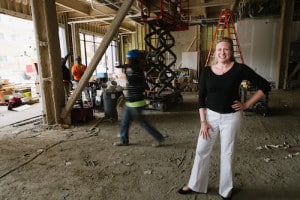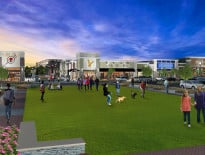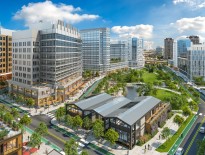Sarah Barnat
President, Barnat Development
Age: 42
Industry experience: 16 years

Steve Adams
Sarah Barnat’s career in real estate development has spanned projects in two of Boston’s fastest-changing neighborhoods, South End and East Boston, as a project manager for Trinity Financial and National Development. After a stint as executive director of Urban Land Institute-Boston, Barnat went into business for herself in 2015 with a focus on transit-oriented multifamily development in the suburbs. Her first completed project is Holmes Beverly, a 67-unit mixed-income rental complex next to the MBTA commuter rail’s Beverly Depot station.
Q: How does Gov. Charlie Baker’s real estate asset disposition program fit into your company’s strategy?
A: It is the A-number one strategy and the project, Holmes Beverly at the Beverly Depot train station, is one of the first successfully closed and constructed projects. We’re able to leverage MBTA land that was crying out for disposition. It had already been permitted by the city of Beverly under a special permit. The city gets it. They really were encouraging a district where they had density around the train station.
Q: What’s the history of that parcel?
A: It was old gas stations and some vacant land. The T, about 10 years ago, started a planning process with the city to develop a parking garage. They developed a 500-car garage with the intent of it being a mixed-use development. Then the city created an overlay district that allowed up to 75 feet in height, one-to-one parking ratios, all the transit-oriented principles we look for as developers. The city seemed to be a city I wanted to do business with.
The RFP came out at the same time as MassHousing’s workforce housing program. That offered some resources to integrate workforce housing. My equity partner is Massachusetts Housing Investment Corp. which had started a healthy neighborhoods equity fund. They were my sole equity provider and it worked extraordinarily well for the site. They are looking for market-rate returns but with the added social benefits.
And finally, MassDevelopment backed up the personal guarantees that I have to put up as a developer. We just opened our model units, two years to the day of me being designated, which is warp speed in the world of MBTA dispositions.
Q: What other suburban towns seem open to this development approach?
A: This is the critical issue about Eastern Massachusetts growth. Personally I am not at all interested in participating in a project that requires town meeting. I don’t have the risk profile for it. The process is very difficult to take on. I appreciate the city form of government, where we have cities that have the leadership and professional planning staff who can shepherd these projects along. There’s a number of North Shore cities that have that potential: the Reveres, the Lynns, the Salems of the world.
Q: What neighborhoods will be next to transform like South End and East Boston?
A: There’s still items to be done in East Boston. I’m excited to see what happens at Suffolk Downs and the surrounding area. That’s one of the last large-scale places that we can have a significant impact on the quality of life and economic development of the city.
Personally I am a fan of the inner-ring suburbs, too – Everett, Malden, Melrose – that are connected via transit and have progressive leadership and have a need for economic development. Because I also don’t like to drive. That’s why Beverly attracted me. It has 68 trains a day with 10-minute headways at rush hour. You’re 31 minutes to North Station.
I’d been an earlier believer in the Bulfinch Triangle with Avenir and One Canal. I’m so excited to see the TD Garden becoming a job center and to create jobs that are connected to the North Shore.
Q: You submitted a response to the Housing Innovation Lab’s request for ideas on how to build housing on municipally-owned properties in Boston. How much potential does that idea have?
A: Being a city of Boston resident and having done the majority of my projects in the city – I think I’ve permitted over 1,700 units in Boston – I thought I could work with a few other well-known women developers, including Eliza Datta and Loryn Sheffner, to offer up some ideas. What is appropriate as far as size and density on these parcels that could be economically feasible?
I appreciate the city is taking a broader view at the disposition piece. Although the three of us didn’t have any specific sites in mind, we thought we could provide a little thought leadership as far as what developers could look at through an RFI process. There are some great sites and there are some sites that just don’t seem feasible.
What jumped out at me were the library assets. We have a beautiful new library in East Boston where I live. When I look at the West End library, for instance, it’s screaming out for redevelopment that could be a more functional piece of the community fabric. But it also has a lot of density possibilities. If they come out with RFPs, it’s something I might consider, but it was more an exercise in civic responsibility.
Barnat’s Five Favorite Things to Do This Summer Without a Car:
- Commuter rail to Beverly to catch a show at the Cabot Theater.
- MBTA ferry to Charlestown, Hingham or Hull to see Boston from the harbor.
- Downeaster train to Portland, Maine for lobster rolls and shopping.
- ICA Water Taxi to East Boston Shipyard for art, Downeast Cider and KO Pies.
- Blue Line T to Revere Beach for Bianchi’s Pizza and a dip in the ocean.







